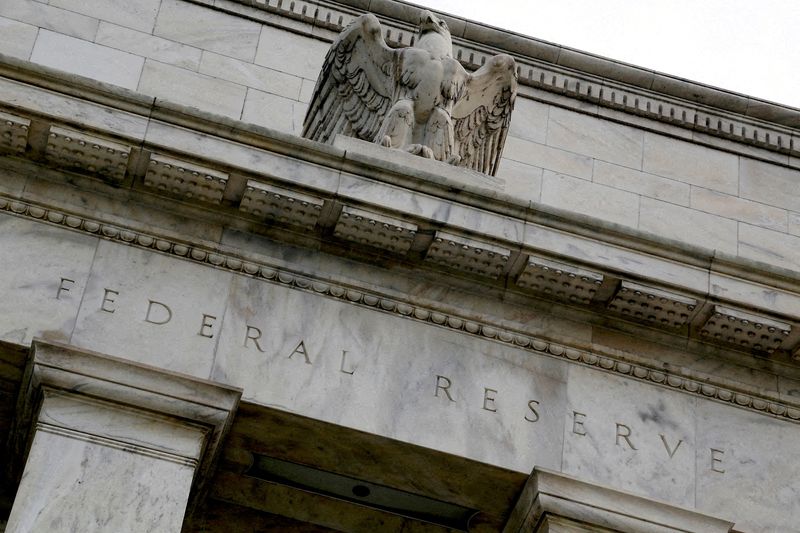By Carolina Mandl, Davide Barbuscia and Lewis Krauskopf
(Reuters) -Fears of rebounding inflation are forcing investors to prepare for a scenario few expected to confront in 2024: a year without U.S. interest rate cuts.
Expectations for how much policy easing the Federal Reserve can deliver are falling rapidly as one strong economic report after another suggests inflation could come creeping back if the U.S. central bank lowers borrowing costs prematurely.
Those worries took on added urgency following the release on Wednesday of robust consumer price data: futures markets now show investors expect rates to fall by just 40 basis points this year, compared to the 150 basis points that were priced in at the start of 2024.
The fading prospect of rate cuts presents a dilemma to market participants who piled into stocks and bonds over the last few months in hopes of a policy easing, leaving some of them scrambling to readjust their portfolios.
Though the S&P 500 index stands near record highs, some equity investors are loading up on insurance in the options market or pouring money into popular inflation hedges such as energy stocks, wary that a key bull market support may be fading. The index fell about 1% on Wednesday.
Bond investors are already feeling the pain, as they reposition portfolios amidst a weeks-long selloff that has hammered Treasury prices. Benchmark 10-year yields, which move inversely to bond prices, hit their highest level since November on Wednesday as they breached 4.5%, while two-year yields hit 5% on Thursday. Analysts rushed to upgrade forecasts to push back rate cut expectations, with many of them now expecting two cuts rather than three or four this year.
"We are heading to the possibility of no U.S. rate cuts in 2024, or at least fewer cuts than the market currently prices," said Tara Hariharan, managing director of global macro research at NWI Management.
INFLATION WORRIES
Investors cheered when Fed Chair Jerome Powell in December confirmed expectations of a pivot towards rate cuts and U.S. central bank policymakers penciled in 75 basis points of reductions in borrowing costs for 2024, though that outlook was contingent on inflation continuing to cool.
The S&P 500 has added some $4.7 trillion in market value since then and climbed to record highs as investors bet on a so-called "soft landing" scenario, in which the Fed would be able to tame inflation without triggering a painful recession.
Months of strong data, however, have some investors questioning whether the excitement surrounding a pivot has been premature. Those worries have been readily apparent in the bond market, where yields have been steadily rising in recent weeks.
Tim Murray, a capital markets strategist at T. Rowe Price, said he has been shifting out of fixed income, wary that a possible inflationary rebound could erode bonds' future cash flows.
"Bonds are a really good recession hedge, but they're not a very good hedge against inflation," he said.
Murray also has been increasing positions in energy stocks, which have soared along with oil prices and are a popular inflation hedge. The S&P 500 energy sector is up 17% this year, dwarfing the 8.2% rise of the S&P 500.
Rick Rieder, chief investment officer of global fixed income at BlackRock (NYSE:BLK), the world's largest asset manager, said he had reduced the interest rate exposure of some of the portfolios he runs, including the $2.7 billion BlackRock Flexible Income ETF, over the past few months by selling certain shorter and longer-dated bonds that could be hit harder if rates move higher.
U.S. bond giant PIMCO, in contrast, has been raising its interest rate exposure, or duration, believing that bonds have become more fairly priced following the latest selloff. The company trimmed its rate-cut forecast last week after the release of strong U.S. labor market data.
"If anything, we're looking potentially at when we should be getting overweight," said Mike Cudzil, a portfolio manager at PIMCO.
NWI's Hariharan said yields on longer-dated U.S. government bonds are "too low, given heavy Treasury supply."
'PARKING SPOT'
Meanwhile, signs of caution are growing in the equity market. Bank of America clients sold a net $3.4 billion in equities last week, with individual stocks seeing their largest outflows since July 2023, the firm said in a note.
Scott Wren, senior global market strategist at Wells Fargo Investment Institute, said his firm has been positioned in short-term fixed income as a "parking spot" as it waits for an equities pullback to put money into stocks.
"The next move by the Fed is down, but you're going to have to wait," he said.
Stock investors are also seeking protection in derivatives markets. The Cboe Volatility Index - an options-based gauge of investors' demand for portfolio protection - is hovering near a two-month high.
Citi strategists, analyzing the historic relationship between stocks and yields, said in a note late on Wednesday that it would take the pricing out of 50 to 75 basis points of Fed cuts and a rise between 5 and 35 basis points in the 10-year yield over the next four to five weeks to badly hurt equities.

For Bryant VanCronkhite, senior global equity portfolio manager at Allspring Global Investments, a continued rise in commodity prices could be a major risk for equities, as it could accelerate inflation and price out rate cuts. He believes markets stand at a juncture where it is difficult to predict the next move in stocks.
"Quite honestly, I don't know if it'll be up 10% or down 10%," he said.